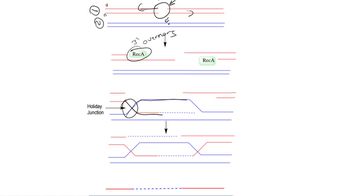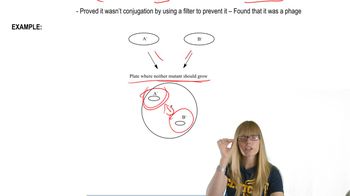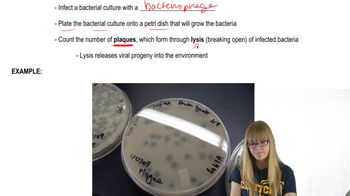Seven deletion mutations (1 to 7 in the table below) are tested for their ability to form wild-type recombinants with five point mutations (a to e). The symbol "+" indicates that wild-type recombination occurs, and "-" indicates that wild types are not formed. Use the data to construct a genetic map of the order of point mutations, and indicate the segment deleted by each deletion mutation.
Table of contents
- 1. Introduction to Genetics51m
- 2. Mendel's Laws of Inheritance3h 37m
- 3. Extensions to Mendelian Inheritance2h 41m
- 4. Genetic Mapping and Linkage2h 28m
- 5. Genetics of Bacteria and Viruses1h 21m
- 6. Chromosomal Variation1h 48m
- 7. DNA and Chromosome Structure56m
- 8. DNA Replication1h 10m
- 9. Mitosis and Meiosis1h 34m
- 10. Transcription1h 0m
- 11. Translation58m
- 12. Gene Regulation in Prokaryotes1h 19m
- 13. Gene Regulation in Eukaryotes44m
- 14. Genetic Control of Development44m
- 15. Genomes and Genomics1h 50m
- 16. Transposable Elements47m
- 17. Mutation, Repair, and Recombination1h 6m
- 18. Molecular Genetic Tools19m
- 19. Cancer Genetics29m
- 20. Quantitative Genetics1h 26m
- 21. Population Genetics50m
- 22. Evolutionary Genetics29m
5. Genetics of Bacteria and Viruses
Bacteriophage Genetics
Problem 17
Textbook Question
In recombination studies of the rII locus in phage T4, what is the significance of the value determined by calculating phage growth in the K12 versus the B strains of E. coli following simultaneous infection in E. coli B? Which value is always greater?
 Verified step by step guidance
Verified step by step guidance1
Understand the context: The rII locus in phage T4 is used to study genetic recombination. Phage T4 can infect two strains of E. coli: strain B and strain K12. The ability of the phage to grow on these strains depends on whether recombination has occurred.
Recognize the experimental setup: In this experiment, phage T4 is simultaneously infecting E. coli strain B. This allows recombination to occur between the phage genomes. The progeny phages are then tested for their ability to grow on both E. coli B and K12 strains.
Define the significance of the value: The value determined by calculating phage growth on K12 versus B strains reflects the frequency of recombination events. Growth on K12 indicates that recombination has restored the wild-type function of the rII locus, while growth on B indicates the total number of progeny phages.
Identify which value is always greater: The number of phages capable of growing on E. coli B is always greater because all progeny phages (both recombinant and non-recombinant) can grow on this strain. In contrast, only recombinant phages with restored wild-type function can grow on K12.
Conclude the interpretation: The ratio of phage growth on K12 to B provides a measure of recombination frequency. A higher ratio indicates a higher frequency of recombination events that restore the wild-type function of the rII locus.
 Verified video answer for a similar problem:
Verified video answer for a similar problem:This video solution was recommended by our tutors as helpful for the problem above
Video duration:
1mPlay a video:
Was this helpful?
Key Concepts
Here are the essential concepts you must grasp in order to answer the question correctly.
Recombination in Genetics
Recombination is a genetic process where genetic material is exchanged between different chromosomes or within the same chromosome. In the context of phage T4, recombination studies help understand how genetic variation occurs and how traits are inherited. This process is crucial for mapping genetic loci, such as the rII locus, and determining the genetic distance between them.
Recommended video:
Guided course

Recombination after Double Strand Breaks
Phage Growth and Strain Differences
Phage growth refers to the replication and proliferation of bacteriophages, which are viruses that infect bacteria. The K12 and B strains of E. coli exhibit different susceptibilities to phage infection, influencing the efficiency of phage growth. Understanding these differences is essential for interpreting the results of recombination studies, as they can affect the observed outcomes in simultaneous infections.
Recommended video:
Guided course

Transduction
Simultaneous Infection and Value Comparison
Simultaneous infection involves infecting a host cell with multiple phage types at the same time, allowing researchers to study interactions between different phages. In the context of the rII locus, the value calculated from phage growth in K12 versus B strains indicates the efficiency of recombination. Typically, the value associated with the K12 strain is greater due to its higher permissiveness to phage growth, which can lead to more successful recombination events.
Recommended video:
Guided course

Plaques and Experiments

 3:44m
3:44mWatch next
Master Plaques and Experiments with a bite sized video explanation from Kylia
Start learningRelated Videos
Related Practice
Textbook Question
759
views
